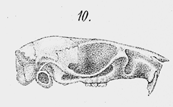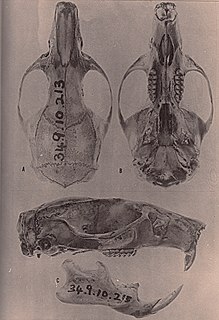
Oryzomys is a genus of semiaquatic rodents in the tribe Oryzomyini living in southern North America and far northern South America. It includes eight species, two of which—the marsh rice rat (O. palustris) of the United States and O. couesi of Mexico and Central America—are widespread; the six others have more restricted distributions. The species have had eventful taxonomic histories, and most species were at one time included in the marsh rice rat; additional species may be recognized in the future. The name Oryzomys was established in 1857 by Spencer Fullerton Baird for the marsh rice rat and was soon applied to over a hundred species of American rodents. Subsequently, the genus gradually became more narrowly defined until its current contents were established in 2006, when ten new genera were established for species previously placed in Oryzomys.
Sooretamys angouya, also known as the rat-headed rice rat, and Paraguayan rice rat, is a rodent species from South America. It is found in northeastern Argentina, southern Brazil and Paraguay in forested areas within the Atlantic Forest and cerrado. Since 2006, it has been classified as the only species in the genus Sooretamys; previously, it was included in the genus Oryzomys. Its taxonomic history has been complex, with the names Oryzomys angouya, Oryzomys buccinatus, and Oryzomys ratticeps in use for various parts of the species at different times. Some variation in its karyotype has been reported, with 2n = 80 to 82 and FN = 88 to 90.
Cerradomys marinhus, also known as Marinho's rice rat, is a rodent species from South America. It is found in Minas Gerais, Brazil. It was formerly known as Oryzomys marinhus, but was transferred to the new genus Cerradomys in 2006.
Oecomys auyantepui, also known as the Guianan oecomys and north Amazonian arboreal rice rat, is a species of rodent in the genus Oecomys from South America. It is found in Guyana, Suriname, French Guiana, and nearby regions of Venezuela and Brazil. It is an arboreal rodent known from the understory of primary rainforest, found at altitudes from sea level to 1100 m.
Oligoryzomys chacoensis, also known as the Chacoan colilargo or Chacoan pygmy rice rat, is a rodent species from South America. It is found in the Gran Chaco region of southeastern Bolivia, southwestern Brazil, Paraguay, and northeastern Argentina. Its karyotype has 2n = 58 and FNa = 74.

Oligoryzomys flavescens, also known as the flavescent colilargo or yellow pygmy rice rat is a species of rodent in the genus Oligoryzomys of family Cricetidae. It is found in southern South America, occurring in southern Brazil, Paraguay, Uruguay, and northeastern Argentina. Its karyotype has 2n = 64-66 and FNa = 66-70.
Oligoryzomys stramineus, also known as the straw-colored colilargo or straw-colored pygmy rice rat, is a species of rodent in the genus Oligoryzomys of the family Cricetidae. It occurs only in the cerrado and caatinga ecoregions of northeastern Brazil. Its karyotype has 2n = 52 and FNa = 68-70.
Nectomys palmipes, also known as the Trinidad nectomys or Trinidad water rat, is a species of semiaquatic rodent in genus Nectomys of family Cricetidae. It is found on the island of Trinidad and on the nearby mainland of Venezuela.

Nectomys is a genus of rodent in the tribe Oryzomyini of family Cricetidae. It is closely related to Amphinectomys and was formerly considered congeneric with Sigmodontomys. It consists of five species, which are allopatrically distributed across much of South America: Nectomys grandis in montane Colombia; Nectomys palmipes on Trinidad and in nearby Venezuela, Nectomys apicalis in the western margins of the Amazon biome, Nectomys rattus in much of Amazonia, and Nectomys squamipes in the Atlantic Forest of Brazil. These species are generally semiaquatic, are normally found near water, and are commonly called water rats.
Nectomys rattus, the small-footed bristly mouse, Amazonian nectomys, Amazonian mouse, or common water rat is a species of rodent in the genus Nectomys of family Cricetidae. It is found in Brazil, Colombia, French Guiana, Guyana, Suriname, and Venezuela, where it lives in a variety of habitats including lowland tropical rainforest, cerrado and caatinga. It is mainly found in areas close to water. It was recognized as distinct only in 2000 and its limits with other Nectomys, including Nectomys apicalis and Nectomys squamipes, remain unclear.
Oligoryzomys andinus, also known as the Andean colilargo or Andean pygmy rice rat, is a species of rodent in genus Oligoryzomys of family Cricetidae. It is found in the Andes of southern Peru and western Bolivia, but may in fact include more than one species. Its karyotype has 2n = 60 and FNa = 70.
Oligoryzomys destructor, also known as Tschudi's colilargo or the destructive pygmy rice rat, is a species of rodent in the genus Oligoryzomys of family Cricetidae. It is found along the eastern Andes from southern Colombia, through Ecuador, Peru, and Bolivia into northern Argentina. Its karyotype has 2n = 60 and FNa = 76.

Oryzomys dimidiatus, also known as the Nicaraguan oryzomys, Thomas's rice rat, or the Nicaraguan rice rat, is a rodent in the family Cricetidae. It is known from only three specimens, all collected in southeastern Nicaragua since 1904. Placed in Nectomys upon its discovery, it was later classified in its own subgenus of Oryzomys and finally recognized as closely related to other species now placed in Oryzomys, including the marsh rice rat and Coues' rice rat, which occurs in the same region.

Mindomys hammondi, also known as Hammond's rice rat or Hammond's oryzomys, is an endangered species of rodent in the tribe Oryzomyini of family Cricetidae. Formerly considered to be related with Nectomys, Sigmodontomys, Megalomys, or Oryzomys, it is now placed in then genus Mindomys, but its relationships remain obscure; some evidence supports a placement near Oecomys or as a basal member of Oryzomyini.
Sigmodontomys is a genus of rodent in the tribe Oryzomyini of family Cricetidae. It is related to Nectomys and Melanomys and used to be included in Nectomys. It includes two species, Sigmodontomys alfari and the much rarer Sigmodontomys aphrastus, but whether these are indeed each other's closest relatives is uncertain.
The Magdalena spiny rat is a species of rodent in the family Echimyidae. It is endemic to Colombia.

Nectomys apicalis, also known as the western Amazonian nectomys, is a semiaquatic species of rodent in the genus Nectomys of family Cricetidae. It is found east of the Andes in Ecuador, Peru, and Bolivia, east into western Brazil; further to the east, it is replaced by N. rattus. It lives near watercourses in lowland tropical rainforest. Its karyotype has 2n = 38–42, and it probably actually represents several distinct undescribed species.
Oligoryzomys fornesi, also known as Fornes' colilargo, is a species of rodent in the genus Oligoryzomys of family Cricetidae. It is found from northeastern Brazil via Paraguay into northeastern Argentina. Its karyotype has 2n = 62 and FNa = 64.
Oligoryzomys moojeni is a species of rodent from South America in the genus Oligoryzomys of family Cricetidae. It is known only from central Brazil, where it is found in the cerrado and gallery forests. It is named after twentieth-century Brazilian zoologist João Moojen. Its karyotype has 2n = 70 and FNa = 84.
Nephelomys meridensis, also known as the Mérida oryzomys, is a species of rodent in the genus Nephelomys of family Cricetidae. It is found in cloud forest in the Sierra Nevada de Mérida of western Venezuela at elevations from 1100 to 4000 m. It is solitary, nocturnal and terrestrial, and has a varied diet.






